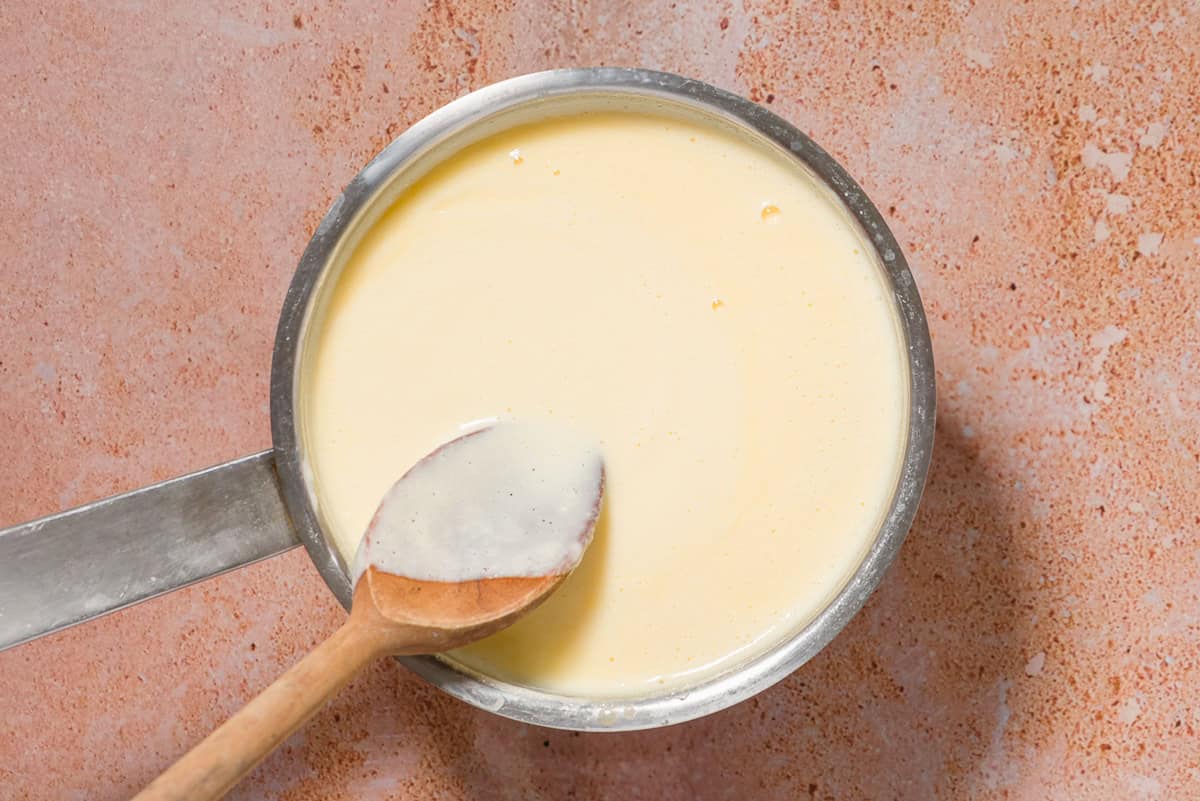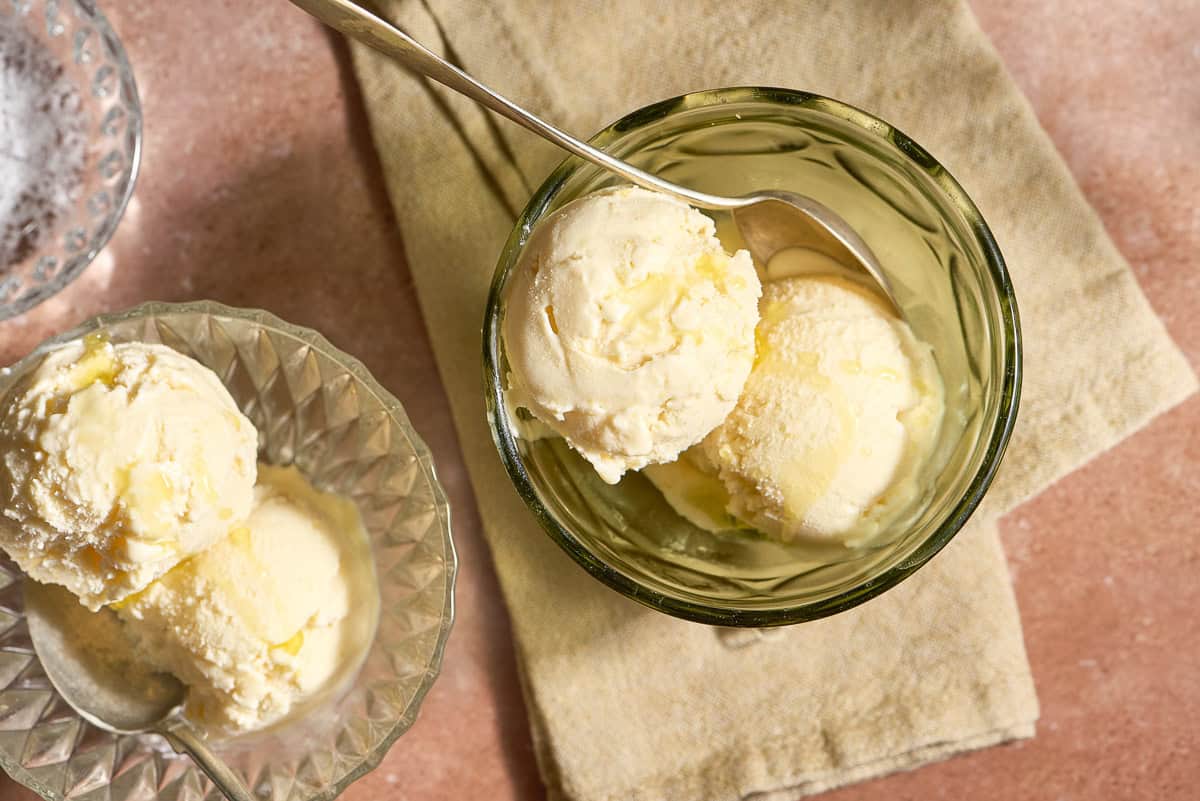Olive oil ice cream is a rich and creamy dessert beautifully balanced with refreshing lemon and a hit of flaky sea salt.

If you’ve never tried olive oil ice cream, you’re in for something truly special. It may initially strike you as unusual, but it’s a culinary combination worth exploring. We all enjoy combinations of fruit and ice cream, so why not embrace olives, which are, after all, a fruit themselves?
The moment I first tried this delightful combination, my heart raced with excitement. It was a revelation for me, and I hope it will be for you, too! Buttery olive oil lends a subtle yet intricate complexity to a custard base. The result is an ice cream with a delicate, silky-smooth texture, a fruity undertone of flavor, a hint of zesty lemon that adds a refreshing twist, and sea salt that punctuates sweet with savory.
If you indulge in ice cream, why not explore something new and maybe even a little sophisticated? Transform this childhood favorite into a grown-up delicacy. Ditch the chocolate syrup and colored sprinkles and opt for a drizzle of liquid gold and a dash of flaky salt!
Table of Contents

What is in Olive Oil Ice Cream?
Once you have made ice cream a few times, I can assure you that you won’t want to buy it anymore. The combinations are endless, and the execution is so simple. Experiment and make your signature flavors. This recipe uses:
- Whole milk is the base of this ice cream. While myriad non-dairy milk options are readily available, this ice cream truly shines when prepared with whole milk. The key to achieving that signature, luscious texture lies in the milk’s fat content—the higher the fat, the velvety and more indulgent your ice cream will be. Opting for low-fat milk may alter the consistency. Lactose-free whole milk can serve as a substitute.
- Heavy cream adds a rich creamy texture to the ice cream. The fat content in cream also helps slow ice crystal formation, leading to a smoother mouthfeel.
- Sugar provides sweetness and prevents the formation of ice crystals during the freezing process. Adjust the sugar amount based on your preference for sweetness; typically, a higher sugar content results in a softer texture for the ice cream. While honey can be used as a substitute for sugar, it has a stronger flavor that may overshadow the subtle taste of the olive oil.
- Egg yolks improve the stability of ice cream by preventing ice crystallization. They act as emulsifiers or stabilizers and add a rich flavor and golden color. Use the whites to make a scramble or a frittata.
- Flaky sea salt dissolves into the custard base and intensifies its sweetness while bringing out the subtle savory note of the olive oil. A finishing sprinkle of light, flaky crystals also provides a delightful crunch that contrasts beautifully with the smooth, creamy base.
- Extra virgin olive oil: Use a light-bodied, fruity extra virgin olive oil for this recipe. More on this below!
- Lemon zest adds freshness and a burst of tartness that balances wonderfully with the olive oil.
Ingredient Spotlight
This olive oil ice cream recipe allows the flavor of olive oil to sing, but not all olive oils are the same! They range from delicate to robust, floral and fruity to bitter and peppery. For this recipe, choose a light olive oil with a creamy, floral flavor. We recommend our buttery, smooth Nocellara olive oil for this recipe.
- Read More: Olive Oil 101: Everything You Need to Know
- Try It: Italian Nocellara Extra Virgin Olive Oil from Sicily
How to Make Olive Oil Ice Cream
This is not a complicated recipe; however, an ice cream maker is necessary. There are just two main steps: first, prepare the ice cream base, and second, add the flavoring. Then let the machine do the rest! Here’s how to make it.
- Warm the base. Start by heating 1 1/2 cups (350 ml) whole milk and 1 1/2 cups (350 ml) heavy cream to between 170°F and 180°F in a saucepan over medium heat. Allow it to simmer gently, but do not let it boil. While the milk-cream mixture warms, combine 4 egg yolks and 3/4 cup (130g) sugar in a separate heat-proof bowl. Whisk them together until they are well blended and creamy.
- Temper the eggs. Use a ladle to slowly add half of the hot milk mixture into the egg yolk mixture, whisking continuously. Make sure you’re pouring in a slow, thin stream to prevent curdling the eggs.
- Cook the custard base. Return the egg mixture to the saucepan with the remaining milk mixture. Cook it over medium heat, stirring constantly, until it thickens and coats the back of a spoon, about 5 to 7 minutes.
- Strain and refrigerate. Set a fine mesh sieve over a medium bowl and strain the mixture into the bowl. To cool it quickly, place the bowl inside a larger bowl filled with ice and a little water, then transfer it to the refrigerator for at least an hour.
- Add flavorings. Once the mixture is cold, add 1/3 cup (75ml) extra virgin olive oil, 1 1/2 teaspoons (3g) flaky sea salt, and 1 tablespoon lemon zest. Mix thoroughly until the salt dissolves and everything is well combined.
- Churn the ice cream. Pour the mixture into your ice cream maker and churn it according to the manufacturer’s instructions.
- Freeze. After churning, you can enjoy it immediately as soft-serve or for a scoopable texture, transfer the mixture into a sealed container, and freeze for at least 4 hours.
- Serve. Finally, scoop the ice cream into bowls and top it with an additional pinch of flaky sea salt and a drizzle of extra virgin olive oil, if you like.
Tips for Making Olive Oil Ice Cream
I love this recipe because it feels fancy but is relatively simple to make, but there are a few technical points to keep in mind to yield the best results!
- Quality of Ingredients: Opting for premium eggs is a game-changer for flavor. They contribute a richer taste and creamier texture to your ice cream, making a distinct difference in the final product.
- Freshness of Olive Oil: Always use fresh olive oil; avoid any that has been sitting in your pantry for months. Olive oil can go rancid and develop a bitter taste over time.
- Chill Thoroughly: For optimal results, chill your custard for at least one hour, although you can leave it in the fridge for longer. The colder the custard, the better it churns, resulting in a lighter, airier ice cream.
- Keep Whisking: When you first incorporate the olive oil into the ice cream base, it may seem like the ingredients won’t emulsify. This is normal! Continue whisking, and the oil will eventually blend into the mixture.
- Temperature Matters: Do not add the olive oil until the custard base has cooled completely. Through experimentation, I found that adding olive oil to a warm mixture dulls its robust flavor. When added to a pre-cooled base, the olive oil retains its vibrant and aromatic qualities, enhancing the overall taste of the ice cream.

Make it Your Own
This ice cream recipe base can also serve as a versatile foundation. You can adjust the ingredients to achieve various flavors to complement the lemon, olive oil, and sea salt, or omit them and use this base with any other flavorings you like. Here are some suggestions:
- Citrus flavors: Instead of lemon zest, consider using the zest from oranges, limes, or tangerines for a refreshing twist.
- Honey-Olive Oil Ice Cream: Substitute sugar with honey. However, use mild-flavored honey and limit the amount to no more than 1/4 cup, as honey has a strong flavor.
- Chocolate Olive Oil Ice Cream: Whisk in 1/4 cup unsweetened cocoa into the custard base once the eggs have been tempered and returned to the pot to thicken. For added texture, you can also include chocolate chips.
- Herb Flavors: To experiment with savory ice creams, infuse the custard base with ingredients like bay leaf, rosemary, or lavender.
More Mediterranean-Inspired Frozen Desserts
Browse all Mediterranean recipes.
Visit Our Shop.
Olive Oil Ice Cream

Equipment
Ingredients
- 1 1/2 cups whole milk
- 1 1/2 cups heavy cream
- 4 egg yolks
- 3/4 cup granulated sugar
- 1/3 cup extra virgin olive oil
- 1 tablespoon lemon zest (from 1 to 2 lemons)
- 1 1/2 teaspoons flaky sea salt
Instructions
- Warm the base. Start by heating the milk and cream to between 170 and 180°F in a saucepan over medium heat. Allow it to simmer gently, but do not let it boil. While the milk-cream mixture warms, combine the egg yolks and sugar in a separate heat-proof bowl. Whisk them together until they are well blended and creamy.
- Temper the eggs. Using a ladle slowly pour half of the hot milk mixture into the egg yolk mixture, whisking continuously. Add the ladles of the egg mixture in a thin, slow stream to prevent the eggs from curddling.
- Cook the custard base. Return the egg mixture to the saucepan with the remaining milk mixture. Cook it over medium heat, stirring constantly, until it thickens and coats the back of a spoon, about 5 to 7 minutes.
- Strain and refrigerate. Set a fine mesh sieve over a medium bowl and strain the mixture into the bowl. To cool it quickly, place the bowl indice a larger bowl filled with ice and a little water, then transfer it to the refrigerator for at least an hour.
- Add flavorings. Once the mixture is cold, add the olive oil, sea salt, and lemon zest. Mix thoroughly until the salt dissolves and everything is well combined.
- Churn the ice cream. Pour the mixture into your ice cream maker and churn it according to the manufacturer’s instructions.
- Freeze. After churning, transfer the mixture into a sealed container For a scoopable texture, freeze it for at least 4 hours. If you prefer, you can enjoy it immediately as a soft-serve option.
- Serve. Finally, scoop the ice cream into bowls and top it with a pinch of flaky sea salt flakes and a drizzle of olive oil, if you like.
Notes
- Shop this recipe: Visit our shop to browse quality Mediterranean ingredients including the olive oil used in this recipe.
- Chill Thoroughly: For optimal results, chill your custard for at least one hour, although you can leave it in the fridge for longer. The colder the custard, the better it churns, resulting in a lighter, airier ice cream.
- Temperature Matters: Do not add the olive oil until the custard base has cooled completely. Through experimentation, I found that adding olive oil to a warm mixture dulls its robust flavor. When added to a pre-cooled base, the olive oil retains its vibrant and aromatic qualities, enhancing the overall taste of the ice cream.
- Keep Whisking: When you first incorporate the olive oil into the ice cream base, it may seem like the ingredients won’t emulsify. This is normal! Continue whisking and the oil will eventually blend into the mixture.
- Storage: Pressing parchment paper directly onto the ice cream before sealing the container to help prevent freezer burn. Ice cream is optimally enjoyed within two weeks. For ideal results, let the ice cream sit at room temperature for a few minutes to soften slightly before serving, making scooping easier.
Nutrition
Bundle and Save!
Four of our best-selling signature olive oils, perfect for everyday use.












